Policies and Procedure for Maintaining Privacy and Confidentiality
VerifiedAdded on 2023/06/07
|11
|2502
|403
AI Summary
This article discusses the policies and procedures for maintaining privacy and confidentiality at Desklib. It covers topics such as informed consent, conflict of interest, environmental sustainability, and cultural differences. The article also includes a sample complaint handling policy and procedure, as well as tips for monitoring staff performance.
Contribute Materials
Your contribution can guide someone’s learning journey. Share your
documents today.
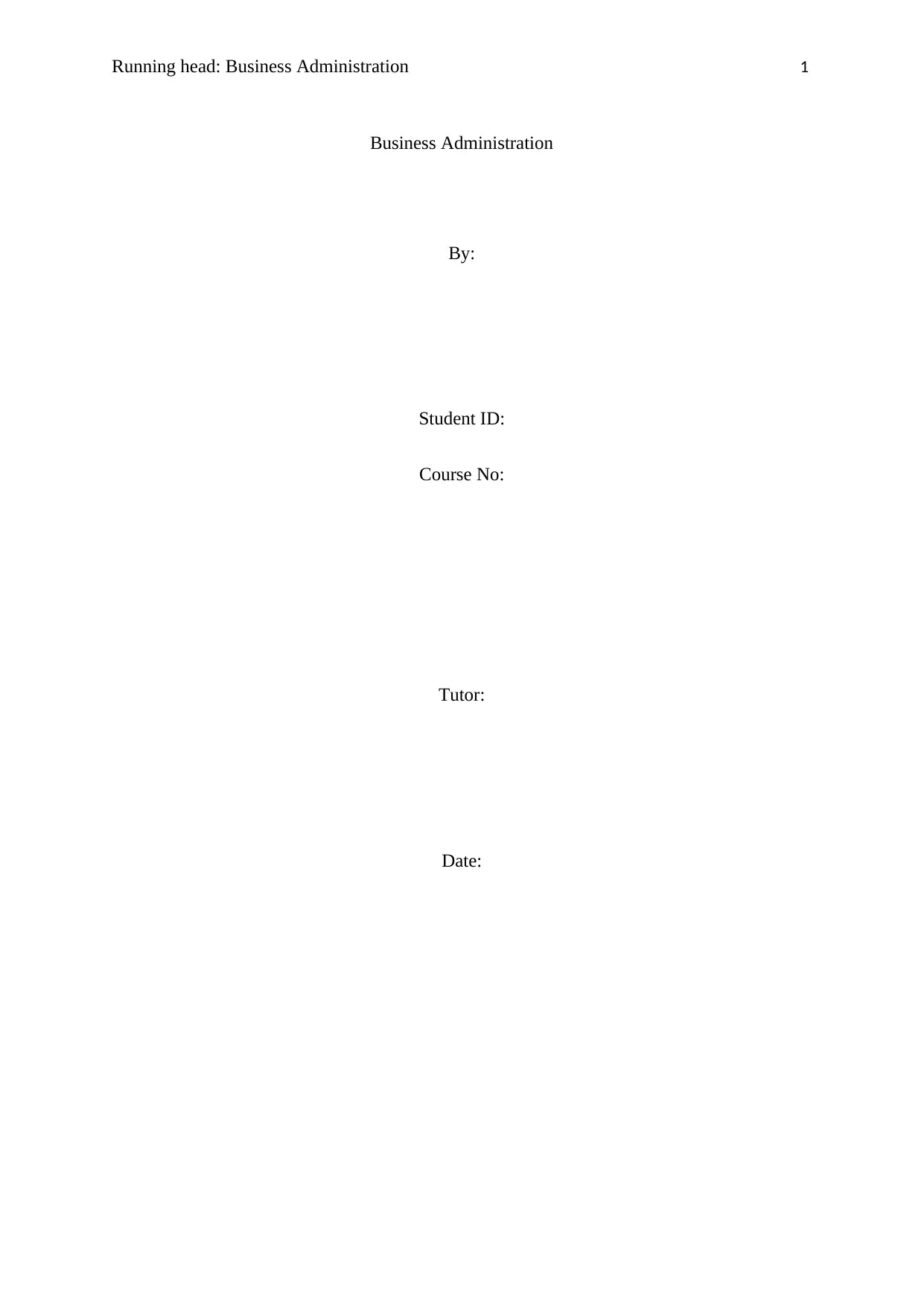
Running head: Business Administration 1
Business Administration
By:
Student ID:
Course No:
Tutor:
Date:
Business Administration
By:
Student ID:
Course No:
Tutor:
Date:
Secure Best Marks with AI Grader
Need help grading? Try our AI Grader for instant feedback on your assignments.
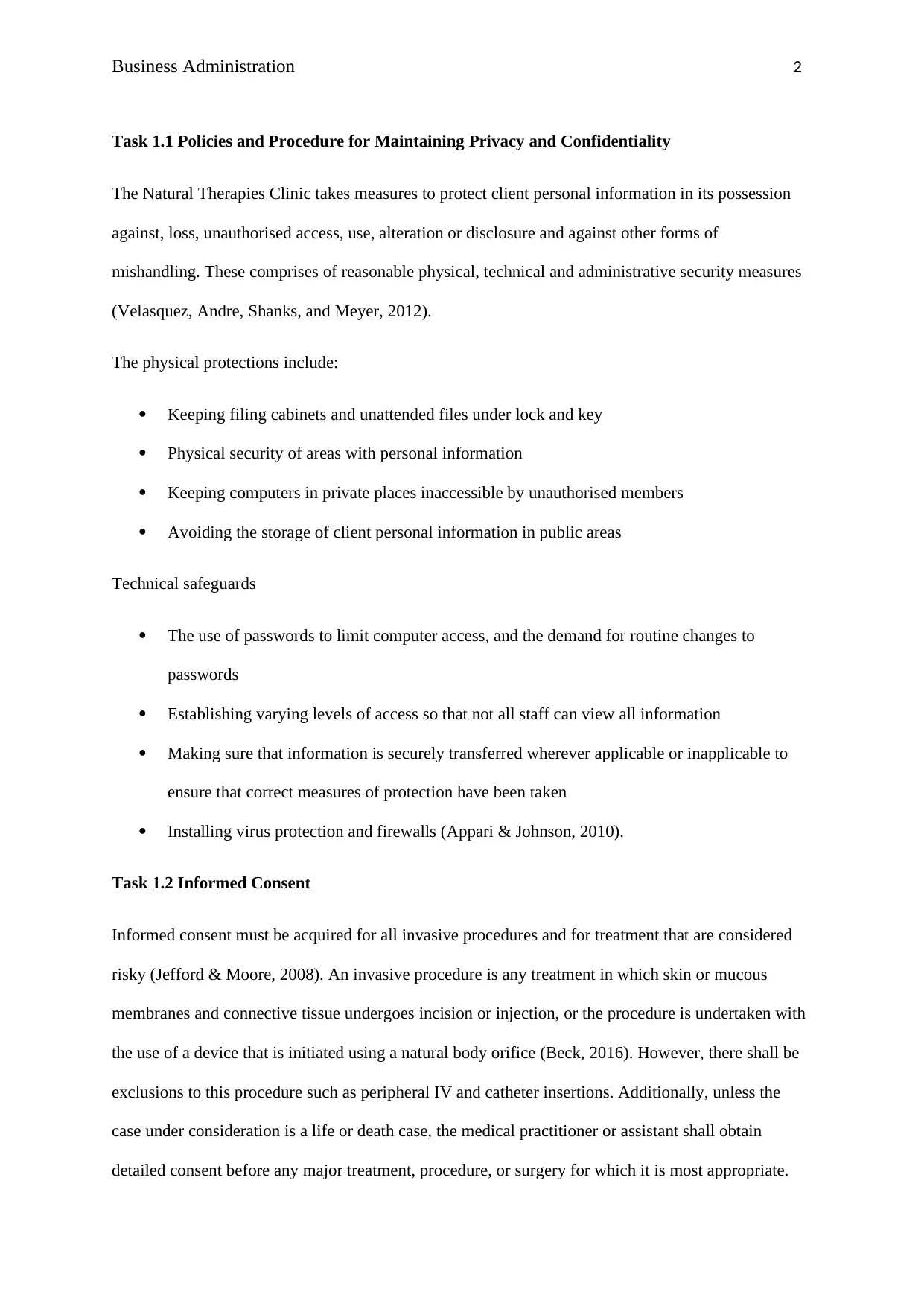
Business Administration 2
Task 1.1 Policies and Procedure for Maintaining Privacy and Confidentiality
The Natural Therapies Clinic takes measures to protect client personal information in its possession
against, loss, unauthorised access, use, alteration or disclosure and against other forms of
mishandling. These comprises of reasonable physical, technical and administrative security measures
(Velasquez, Andre, Shanks, and Meyer, 2012).
The physical protections include:
Keeping filing cabinets and unattended files under lock and key
Physical security of areas with personal information
Keeping computers in private places inaccessible by unauthorised members
Avoiding the storage of client personal information in public areas
Technical safeguards
The use of passwords to limit computer access, and the demand for routine changes to
passwords
Establishing varying levels of access so that not all staff can view all information
Making sure that information is securely transferred wherever applicable or inapplicable to
ensure that correct measures of protection have been taken
Installing virus protection and firewalls (Appari & Johnson, 2010).
Task 1.2 Informed Consent
Informed consent must be acquired for all invasive procedures and for treatment that are considered
risky (Jefford & Moore, 2008). An invasive procedure is any treatment in which skin or mucous
membranes and connective tissue undergoes incision or injection, or the procedure is undertaken with
the use of a device that is initiated using a natural body orifice (Beck, 2016). However, there shall be
exclusions to this procedure such as peripheral IV and catheter insertions. Additionally, unless the
case under consideration is a life or death case, the medical practitioner or assistant shall obtain
detailed consent before any major treatment, procedure, or surgery for which it is most appropriate.
Task 1.1 Policies and Procedure for Maintaining Privacy and Confidentiality
The Natural Therapies Clinic takes measures to protect client personal information in its possession
against, loss, unauthorised access, use, alteration or disclosure and against other forms of
mishandling. These comprises of reasonable physical, technical and administrative security measures
(Velasquez, Andre, Shanks, and Meyer, 2012).
The physical protections include:
Keeping filing cabinets and unattended files under lock and key
Physical security of areas with personal information
Keeping computers in private places inaccessible by unauthorised members
Avoiding the storage of client personal information in public areas
Technical safeguards
The use of passwords to limit computer access, and the demand for routine changes to
passwords
Establishing varying levels of access so that not all staff can view all information
Making sure that information is securely transferred wherever applicable or inapplicable to
ensure that correct measures of protection have been taken
Installing virus protection and firewalls (Appari & Johnson, 2010).
Task 1.2 Informed Consent
Informed consent must be acquired for all invasive procedures and for treatment that are considered
risky (Jefford & Moore, 2008). An invasive procedure is any treatment in which skin or mucous
membranes and connective tissue undergoes incision or injection, or the procedure is undertaken with
the use of a device that is initiated using a natural body orifice (Beck, 2016). However, there shall be
exclusions to this procedure such as peripheral IV and catheter insertions. Additionally, unless the
case under consideration is a life or death case, the medical practitioner or assistant shall obtain
detailed consent before any major treatment, procedure, or surgery for which it is most appropriate.
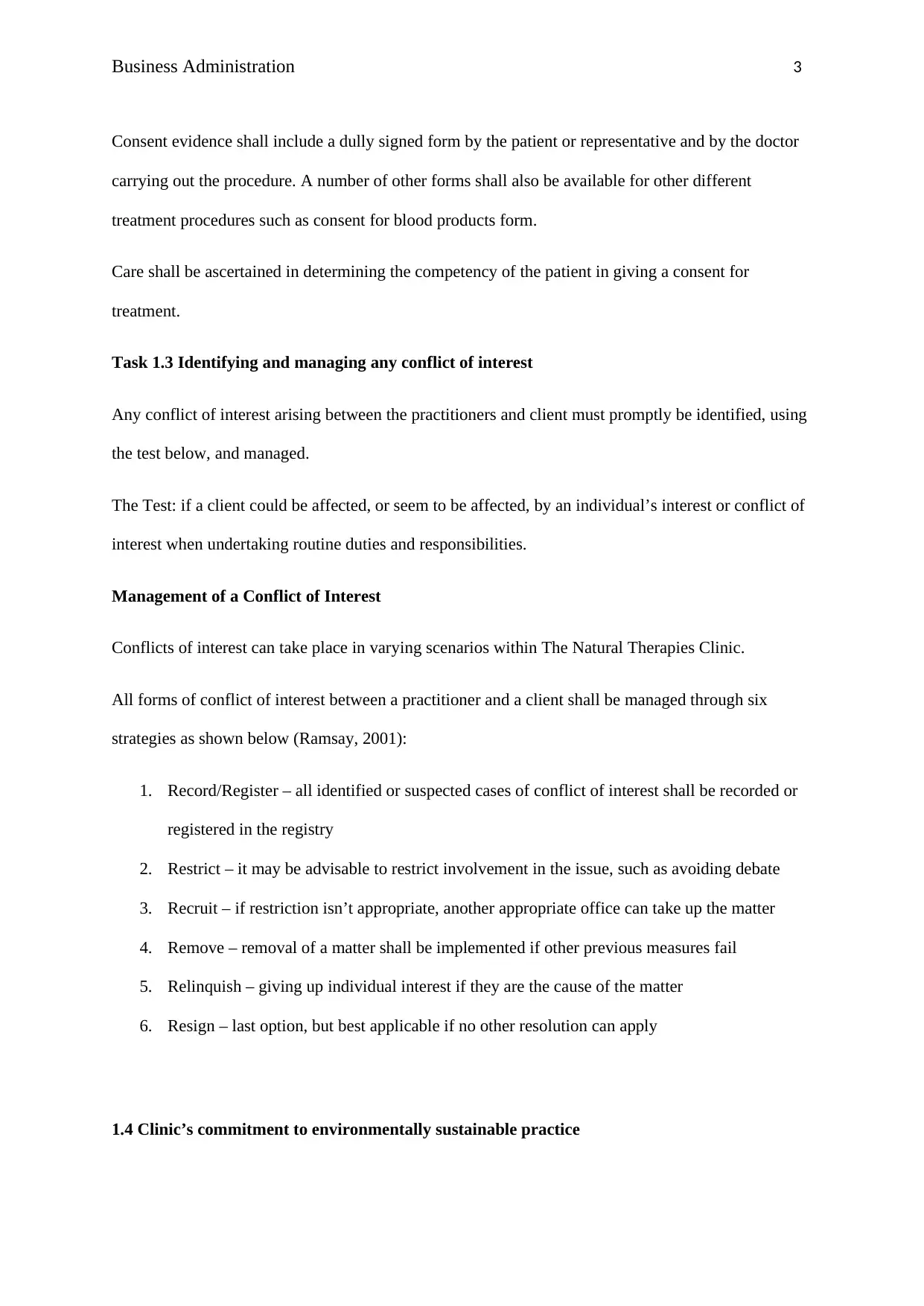
Business Administration 3
Consent evidence shall include a dully signed form by the patient or representative and by the doctor
carrying out the procedure. A number of other forms shall also be available for other different
treatment procedures such as consent for blood products form.
Care shall be ascertained in determining the competency of the patient in giving a consent for
treatment.
Task 1.3 Identifying and managing any conflict of interest
Any conflict of interest arising between the practitioners and client must promptly be identified, using
the test below, and managed.
The Test: if a client could be affected, or seem to be affected, by an individual’s interest or conflict of
interest when undertaking routine duties and responsibilities.
Management of a Conflict of Interest
Conflicts of interest can take place in varying scenarios within The Natural Therapies Clinic.
All forms of conflict of interest between a practitioner and a client shall be managed through six
strategies as shown below (Ramsay, 2001):
1. Record/Register – all identified or suspected cases of conflict of interest shall be recorded or
registered in the registry
2. Restrict – it may be advisable to restrict involvement in the issue, such as avoiding debate
3. Recruit – if restriction isn’t appropriate, another appropriate office can take up the matter
4. Remove – removal of a matter shall be implemented if other previous measures fail
5. Relinquish – giving up individual interest if they are the cause of the matter
6. Resign – last option, but best applicable if no other resolution can apply
1.4 Clinic’s commitment to environmentally sustainable practice
Consent evidence shall include a dully signed form by the patient or representative and by the doctor
carrying out the procedure. A number of other forms shall also be available for other different
treatment procedures such as consent for blood products form.
Care shall be ascertained in determining the competency of the patient in giving a consent for
treatment.
Task 1.3 Identifying and managing any conflict of interest
Any conflict of interest arising between the practitioners and client must promptly be identified, using
the test below, and managed.
The Test: if a client could be affected, or seem to be affected, by an individual’s interest or conflict of
interest when undertaking routine duties and responsibilities.
Management of a Conflict of Interest
Conflicts of interest can take place in varying scenarios within The Natural Therapies Clinic.
All forms of conflict of interest between a practitioner and a client shall be managed through six
strategies as shown below (Ramsay, 2001):
1. Record/Register – all identified or suspected cases of conflict of interest shall be recorded or
registered in the registry
2. Restrict – it may be advisable to restrict involvement in the issue, such as avoiding debate
3. Recruit – if restriction isn’t appropriate, another appropriate office can take up the matter
4. Remove – removal of a matter shall be implemented if other previous measures fail
5. Relinquish – giving up individual interest if they are the cause of the matter
6. Resign – last option, but best applicable if no other resolution can apply
1.4 Clinic’s commitment to environmentally sustainable practice
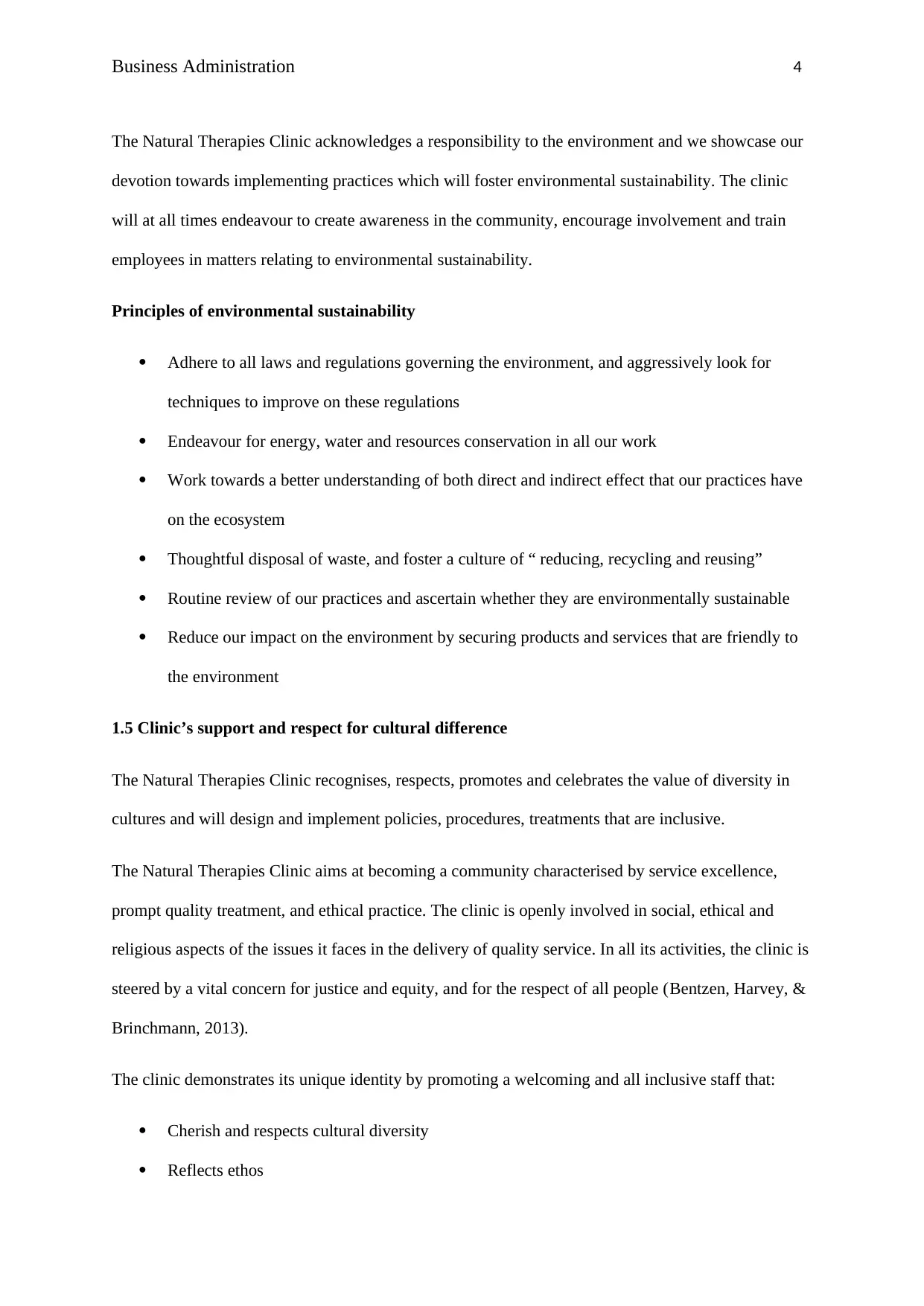
Business Administration 4
The Natural Therapies Clinic acknowledges a responsibility to the environment and we showcase our
devotion towards implementing practices which will foster environmental sustainability. The clinic
will at all times endeavour to create awareness in the community, encourage involvement and train
employees in matters relating to environmental sustainability.
Principles of environmental sustainability
Adhere to all laws and regulations governing the environment, and aggressively look for
techniques to improve on these regulations
Endeavour for energy, water and resources conservation in all our work
Work towards a better understanding of both direct and indirect effect that our practices have
on the ecosystem
Thoughtful disposal of waste, and foster a culture of “ reducing, recycling and reusing”
Routine review of our practices and ascertain whether they are environmentally sustainable
Reduce our impact on the environment by securing products and services that are friendly to
the environment
1.5 Clinic’s support and respect for cultural difference
The Natural Therapies Clinic recognises, respects, promotes and celebrates the value of diversity in
cultures and will design and implement policies, procedures, treatments that are inclusive.
The Natural Therapies Clinic aims at becoming a community characterised by service excellence,
prompt quality treatment, and ethical practice. The clinic is openly involved in social, ethical and
religious aspects of the issues it faces in the delivery of quality service. In all its activities, the clinic is
steered by a vital concern for justice and equity, and for the respect of all people (Bentzen, Harvey, &
Brinchmann, 2013).
The clinic demonstrates its unique identity by promoting a welcoming and all inclusive staff that:
Cherish and respects cultural diversity
Reflects ethos
The Natural Therapies Clinic acknowledges a responsibility to the environment and we showcase our
devotion towards implementing practices which will foster environmental sustainability. The clinic
will at all times endeavour to create awareness in the community, encourage involvement and train
employees in matters relating to environmental sustainability.
Principles of environmental sustainability
Adhere to all laws and regulations governing the environment, and aggressively look for
techniques to improve on these regulations
Endeavour for energy, water and resources conservation in all our work
Work towards a better understanding of both direct and indirect effect that our practices have
on the ecosystem
Thoughtful disposal of waste, and foster a culture of “ reducing, recycling and reusing”
Routine review of our practices and ascertain whether they are environmentally sustainable
Reduce our impact on the environment by securing products and services that are friendly to
the environment
1.5 Clinic’s support and respect for cultural difference
The Natural Therapies Clinic recognises, respects, promotes and celebrates the value of diversity in
cultures and will design and implement policies, procedures, treatments that are inclusive.
The Natural Therapies Clinic aims at becoming a community characterised by service excellence,
prompt quality treatment, and ethical practice. The clinic is openly involved in social, ethical and
religious aspects of the issues it faces in the delivery of quality service. In all its activities, the clinic is
steered by a vital concern for justice and equity, and for the respect of all people (Bentzen, Harvey, &
Brinchmann, 2013).
The clinic demonstrates its unique identity by promoting a welcoming and all inclusive staff that:
Cherish and respects cultural diversity
Reflects ethos
Secure Best Marks with AI Grader
Need help grading? Try our AI Grader for instant feedback on your assignments.
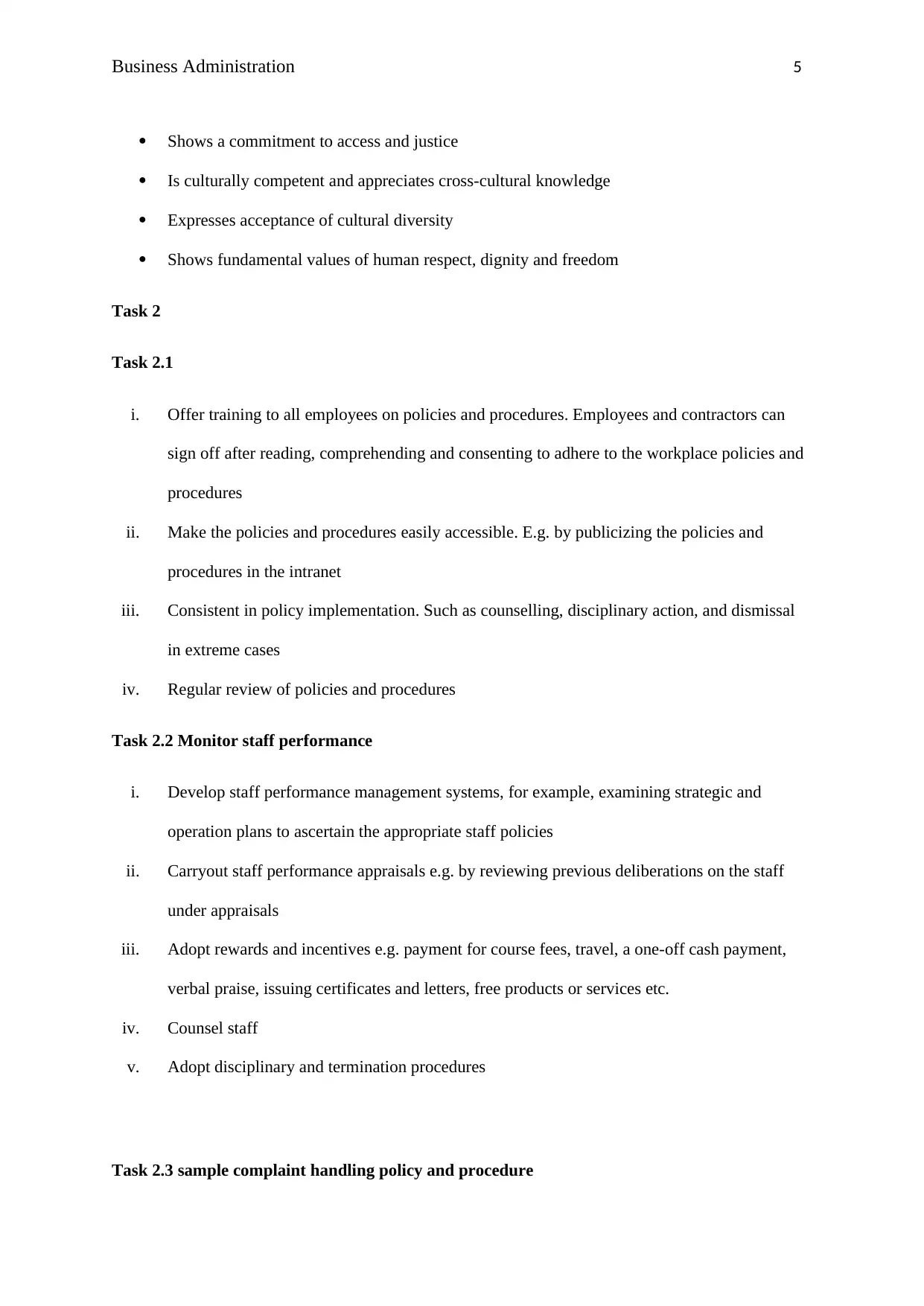
Business Administration 5
Shows a commitment to access and justice
Is culturally competent and appreciates cross-cultural knowledge
Expresses acceptance of cultural diversity
Shows fundamental values of human respect, dignity and freedom
Task 2
Task 2.1
i. Offer training to all employees on policies and procedures. Employees and contractors can
sign off after reading, comprehending and consenting to adhere to the workplace policies and
procedures
ii. Make the policies and procedures easily accessible. E.g. by publicizing the policies and
procedures in the intranet
iii. Consistent in policy implementation. Such as counselling, disciplinary action, and dismissal
in extreme cases
iv. Regular review of policies and procedures
Task 2.2 Monitor staff performance
i. Develop staff performance management systems, for example, examining strategic and
operation plans to ascertain the appropriate staff policies
ii. Carryout staff performance appraisals e.g. by reviewing previous deliberations on the staff
under appraisals
iii. Adopt rewards and incentives e.g. payment for course fees, travel, a one-off cash payment,
verbal praise, issuing certificates and letters, free products or services etc.
iv. Counsel staff
v. Adopt disciplinary and termination procedures
Task 2.3 sample complaint handling policy and procedure
Shows a commitment to access and justice
Is culturally competent and appreciates cross-cultural knowledge
Expresses acceptance of cultural diversity
Shows fundamental values of human respect, dignity and freedom
Task 2
Task 2.1
i. Offer training to all employees on policies and procedures. Employees and contractors can
sign off after reading, comprehending and consenting to adhere to the workplace policies and
procedures
ii. Make the policies and procedures easily accessible. E.g. by publicizing the policies and
procedures in the intranet
iii. Consistent in policy implementation. Such as counselling, disciplinary action, and dismissal
in extreme cases
iv. Regular review of policies and procedures
Task 2.2 Monitor staff performance
i. Develop staff performance management systems, for example, examining strategic and
operation plans to ascertain the appropriate staff policies
ii. Carryout staff performance appraisals e.g. by reviewing previous deliberations on the staff
under appraisals
iii. Adopt rewards and incentives e.g. payment for course fees, travel, a one-off cash payment,
verbal praise, issuing certificates and letters, free products or services etc.
iv. Counsel staff
v. Adopt disciplinary and termination procedures
Task 2.3 sample complaint handling policy and procedure
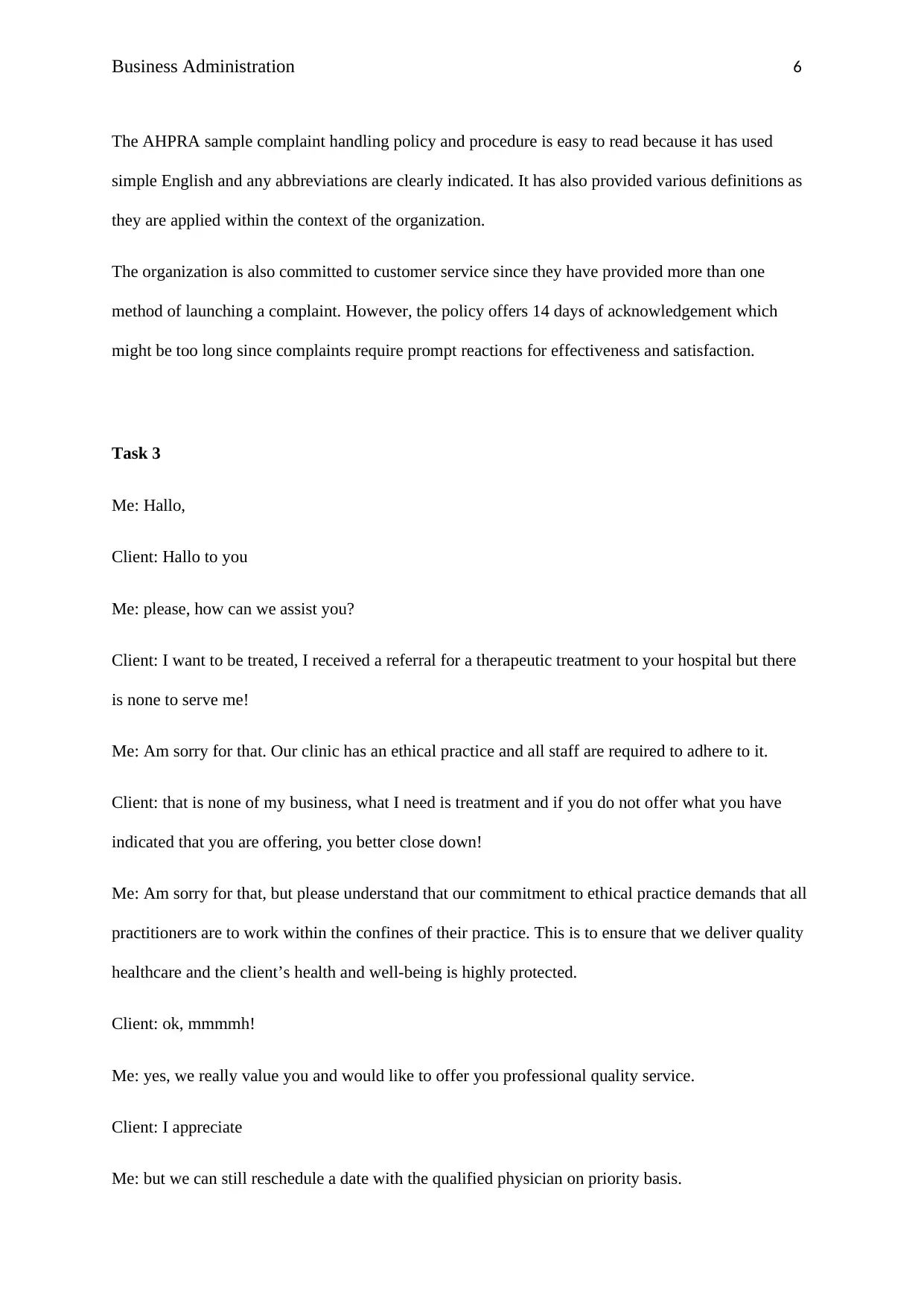
Business Administration 6
The AHPRA sample complaint handling policy and procedure is easy to read because it has used
simple English and any abbreviations are clearly indicated. It has also provided various definitions as
they are applied within the context of the organization.
The organization is also committed to customer service since they have provided more than one
method of launching a complaint. However, the policy offers 14 days of acknowledgement which
might be too long since complaints require prompt reactions for effectiveness and satisfaction.
Task 3
Me: Hallo,
Client: Hallo to you
Me: please, how can we assist you?
Client: I want to be treated, I received a referral for a therapeutic treatment to your hospital but there
is none to serve me!
Me: Am sorry for that. Our clinic has an ethical practice and all staff are required to adhere to it.
Client: that is none of my business, what I need is treatment and if you do not offer what you have
indicated that you are offering, you better close down!
Me: Am sorry for that, but please understand that our commitment to ethical practice demands that all
practitioners are to work within the confines of their practice. This is to ensure that we deliver quality
healthcare and the client’s health and well-being is highly protected.
Client: ok, mmmmh!
Me: yes, we really value you and would like to offer you professional quality service.
Client: I appreciate
Me: but we can still reschedule a date with the qualified physician on priority basis.
The AHPRA sample complaint handling policy and procedure is easy to read because it has used
simple English and any abbreviations are clearly indicated. It has also provided various definitions as
they are applied within the context of the organization.
The organization is also committed to customer service since they have provided more than one
method of launching a complaint. However, the policy offers 14 days of acknowledgement which
might be too long since complaints require prompt reactions for effectiveness and satisfaction.
Task 3
Me: Hallo,
Client: Hallo to you
Me: please, how can we assist you?
Client: I want to be treated, I received a referral for a therapeutic treatment to your hospital but there
is none to serve me!
Me: Am sorry for that. Our clinic has an ethical practice and all staff are required to adhere to it.
Client: that is none of my business, what I need is treatment and if you do not offer what you have
indicated that you are offering, you better close down!
Me: Am sorry for that, but please understand that our commitment to ethical practice demands that all
practitioners are to work within the confines of their practice. This is to ensure that we deliver quality
healthcare and the client’s health and well-being is highly protected.
Client: ok, mmmmh!
Me: yes, we really value you and would like to offer you professional quality service.
Client: I appreciate
Me: but we can still reschedule a date with the qualified physician on priority basis.
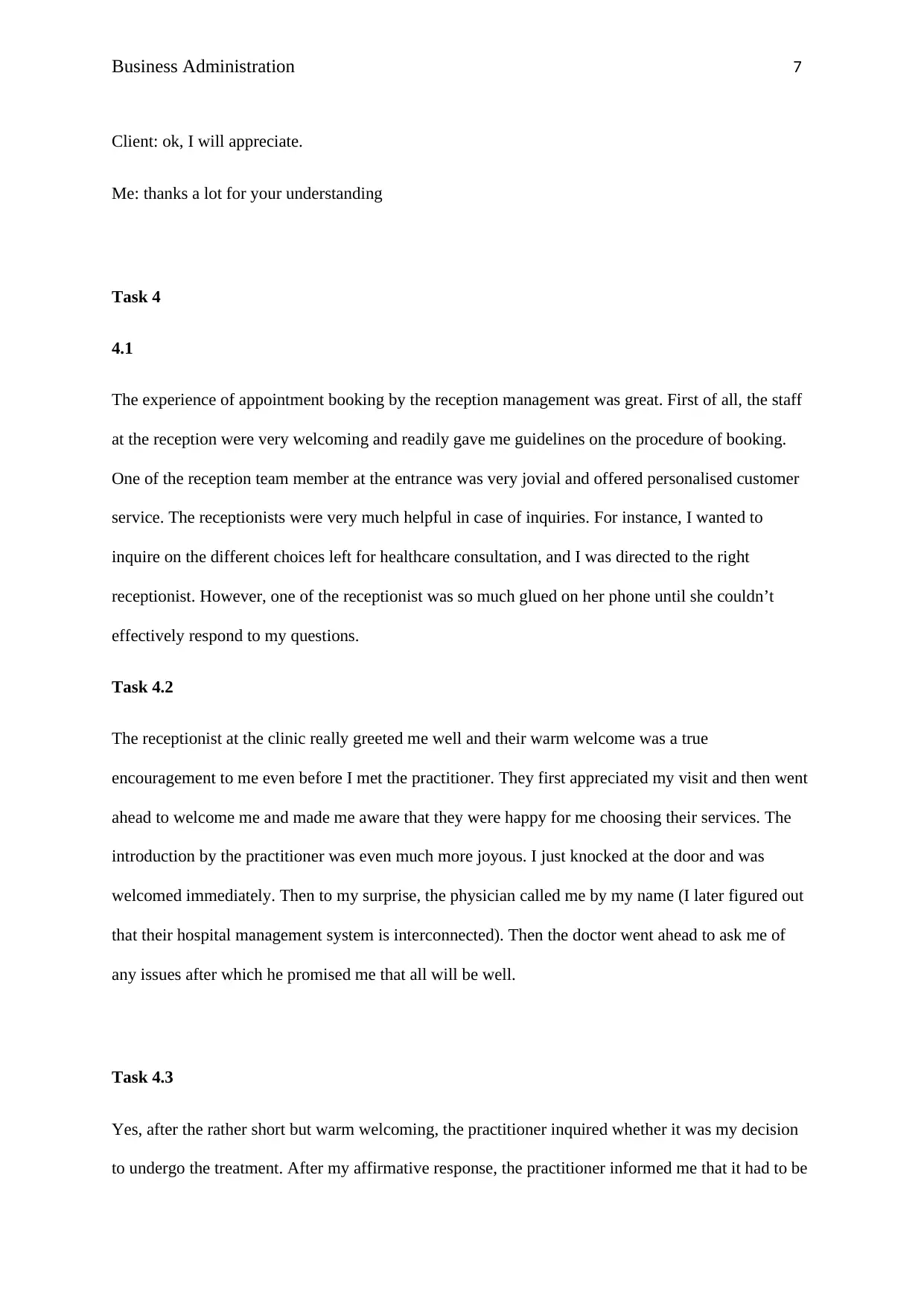
Business Administration 7
Client: ok, I will appreciate.
Me: thanks a lot for your understanding
Task 4
4.1
The experience of appointment booking by the reception management was great. First of all, the staff
at the reception were very welcoming and readily gave me guidelines on the procedure of booking.
One of the reception team member at the entrance was very jovial and offered personalised customer
service. The receptionists were very much helpful in case of inquiries. For instance, I wanted to
inquire on the different choices left for healthcare consultation, and I was directed to the right
receptionist. However, one of the receptionist was so much glued on her phone until she couldn’t
effectively respond to my questions.
Task 4.2
The receptionist at the clinic really greeted me well and their warm welcome was a true
encouragement to me even before I met the practitioner. They first appreciated my visit and then went
ahead to welcome me and made me aware that they were happy for me choosing their services. The
introduction by the practitioner was even much more joyous. I just knocked at the door and was
welcomed immediately. Then to my surprise, the physician called me by my name (I later figured out
that their hospital management system is interconnected). Then the doctor went ahead to ask me of
any issues after which he promised me that all will be well.
Task 4.3
Yes, after the rather short but warm welcoming, the practitioner inquired whether it was my decision
to undergo the treatment. After my affirmative response, the practitioner informed me that it had to be
Client: ok, I will appreciate.
Me: thanks a lot for your understanding
Task 4
4.1
The experience of appointment booking by the reception management was great. First of all, the staff
at the reception were very welcoming and readily gave me guidelines on the procedure of booking.
One of the reception team member at the entrance was very jovial and offered personalised customer
service. The receptionists were very much helpful in case of inquiries. For instance, I wanted to
inquire on the different choices left for healthcare consultation, and I was directed to the right
receptionist. However, one of the receptionist was so much glued on her phone until she couldn’t
effectively respond to my questions.
Task 4.2
The receptionist at the clinic really greeted me well and their warm welcome was a true
encouragement to me even before I met the practitioner. They first appreciated my visit and then went
ahead to welcome me and made me aware that they were happy for me choosing their services. The
introduction by the practitioner was even much more joyous. I just knocked at the door and was
welcomed immediately. Then to my surprise, the physician called me by my name (I later figured out
that their hospital management system is interconnected). Then the doctor went ahead to ask me of
any issues after which he promised me that all will be well.
Task 4.3
Yes, after the rather short but warm welcoming, the practitioner inquired whether it was my decision
to undergo the treatment. After my affirmative response, the practitioner informed me that it had to be
Paraphrase This Document
Need a fresh take? Get an instant paraphrase of this document with our AI Paraphraser
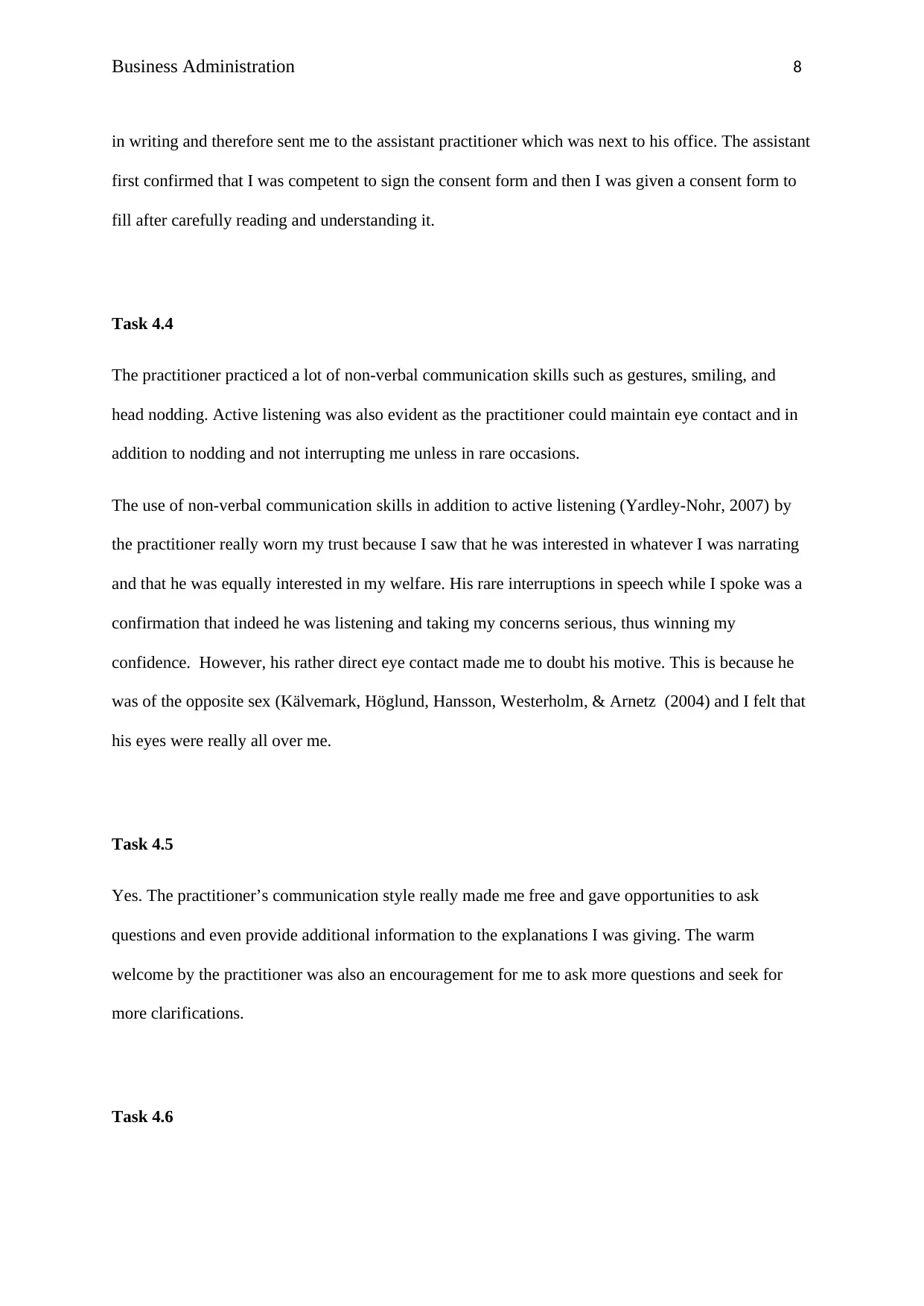
Business Administration 8
in writing and therefore sent me to the assistant practitioner which was next to his office. The assistant
first confirmed that I was competent to sign the consent form and then I was given a consent form to
fill after carefully reading and understanding it.
Task 4.4
The practitioner practiced a lot of non-verbal communication skills such as gestures, smiling, and
head nodding. Active listening was also evident as the practitioner could maintain eye contact and in
addition to nodding and not interrupting me unless in rare occasions.
The use of non-verbal communication skills in addition to active listening (Yardley-Nohr, 2007) by
the practitioner really worn my trust because I saw that he was interested in whatever I was narrating
and that he was equally interested in my welfare. His rare interruptions in speech while I spoke was a
confirmation that indeed he was listening and taking my concerns serious, thus winning my
confidence. However, his rather direct eye contact made me to doubt his motive. This is because he
was of the opposite sex (Kälvemark, Höglund, Hansson, Westerholm, & Arnetz (2004) and I felt that
his eyes were really all over me.
Task 4.5
Yes. The practitioner’s communication style really made me free and gave opportunities to ask
questions and even provide additional information to the explanations I was giving. The warm
welcome by the practitioner was also an encouragement for me to ask more questions and seek for
more clarifications.
Task 4.6
in writing and therefore sent me to the assistant practitioner which was next to his office. The assistant
first confirmed that I was competent to sign the consent form and then I was given a consent form to
fill after carefully reading and understanding it.
Task 4.4
The practitioner practiced a lot of non-verbal communication skills such as gestures, smiling, and
head nodding. Active listening was also evident as the practitioner could maintain eye contact and in
addition to nodding and not interrupting me unless in rare occasions.
The use of non-verbal communication skills in addition to active listening (Yardley-Nohr, 2007) by
the practitioner really worn my trust because I saw that he was interested in whatever I was narrating
and that he was equally interested in my welfare. His rare interruptions in speech while I spoke was a
confirmation that indeed he was listening and taking my concerns serious, thus winning my
confidence. However, his rather direct eye contact made me to doubt his motive. This is because he
was of the opposite sex (Kälvemark, Höglund, Hansson, Westerholm, & Arnetz (2004) and I felt that
his eyes were really all over me.
Task 4.5
Yes. The practitioner’s communication style really made me free and gave opportunities to ask
questions and even provide additional information to the explanations I was giving. The warm
welcome by the practitioner was also an encouragement for me to ask more questions and seek for
more clarifications.
Task 4.6
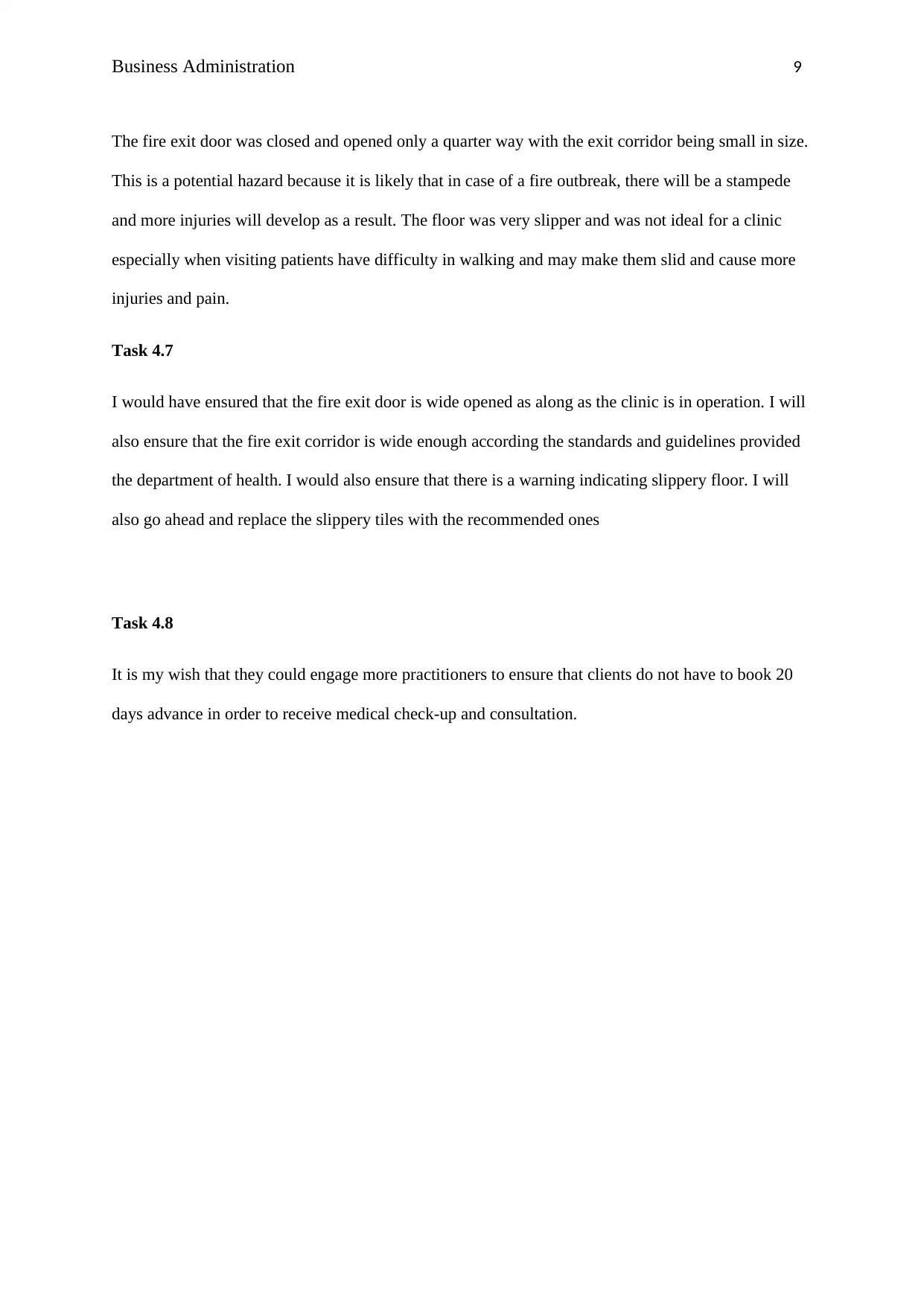
Business Administration 9
The fire exit door was closed and opened only a quarter way with the exit corridor being small in size.
This is a potential hazard because it is likely that in case of a fire outbreak, there will be a stampede
and more injuries will develop as a result. The floor was very slipper and was not ideal for a clinic
especially when visiting patients have difficulty in walking and may make them slid and cause more
injuries and pain.
Task 4.7
I would have ensured that the fire exit door is wide opened as along as the clinic is in operation. I will
also ensure that the fire exit corridor is wide enough according the standards and guidelines provided
the department of health. I would also ensure that there is a warning indicating slippery floor. I will
also go ahead and replace the slippery tiles with the recommended ones
Task 4.8
It is my wish that they could engage more practitioners to ensure that clients do not have to book 20
days advance in order to receive medical check-up and consultation.
The fire exit door was closed and opened only a quarter way with the exit corridor being small in size.
This is a potential hazard because it is likely that in case of a fire outbreak, there will be a stampede
and more injuries will develop as a result. The floor was very slipper and was not ideal for a clinic
especially when visiting patients have difficulty in walking and may make them slid and cause more
injuries and pain.
Task 4.7
I would have ensured that the fire exit door is wide opened as along as the clinic is in operation. I will
also ensure that the fire exit corridor is wide enough according the standards and guidelines provided
the department of health. I would also ensure that there is a warning indicating slippery floor. I will
also go ahead and replace the slippery tiles with the recommended ones
Task 4.8
It is my wish that they could engage more practitioners to ensure that clients do not have to book 20
days advance in order to receive medical check-up and consultation.

Business Administration 10
References
Appari, A., & Johnson, M. E. (2010). Information security and privacy in healthcare: current state of
research. International journal of Internet and enterprise management, 6(4), 279-314.
Beck, M. F. (2016). Theory & Practice of Therapeutic Massage. Nelson Education.
Bentzen, G., Harsvik, A., & Brinchmann, B. S. (2013). “Values That Vanish into Thin Air”: Nurses'
Experience of Ethical Values in Their Daily Work. Nursing research and practice, 2013.
Retrieved from http://downloads.hindawi.com/journals/nrp/2013/939153.pdf
Jefford, M., & Moore, R. (2008). Improvement of informed consent and the quality of consent
documents. The lancet oncology, 9(5), 485-493.
Kälvemark, S., Höglund, A. T., Hansson, M. G., Westerholm, P., & Arnetz, B. (2004). Living with
conflicts-ethical dilemmas and moral distress in the health care system. Social science &
medicine, 58(6), 1075-1084. Retrieved from
http://www.jipts.com/_Uploads/dbsAttachedFiles/Livingwith.pdf
Ramsay, M. A. (2001). Conflict in the health care workplace. Proceedings (Baylor University.
Medical Center), 14(2), 138. Retrieved from
https://www.ncbi.nlm.nih.gov/pmc/articles/PMC1291328/
Velasquez, M., Andre, C., Shanks, T., and Meyer, M.J. (2012). The Markkula Center for Applied
Ethics: Consistency and Ethics. Retrieved from
https://www.scu.edu/ethics/ethics-resources/ethical-decision-making/consistency-and-ethics/
References
Appari, A., & Johnson, M. E. (2010). Information security and privacy in healthcare: current state of
research. International journal of Internet and enterprise management, 6(4), 279-314.
Beck, M. F. (2016). Theory & Practice of Therapeutic Massage. Nelson Education.
Bentzen, G., Harsvik, A., & Brinchmann, B. S. (2013). “Values That Vanish into Thin Air”: Nurses'
Experience of Ethical Values in Their Daily Work. Nursing research and practice, 2013.
Retrieved from http://downloads.hindawi.com/journals/nrp/2013/939153.pdf
Jefford, M., & Moore, R. (2008). Improvement of informed consent and the quality of consent
documents. The lancet oncology, 9(5), 485-493.
Kälvemark, S., Höglund, A. T., Hansson, M. G., Westerholm, P., & Arnetz, B. (2004). Living with
conflicts-ethical dilemmas and moral distress in the health care system. Social science &
medicine, 58(6), 1075-1084. Retrieved from
http://www.jipts.com/_Uploads/dbsAttachedFiles/Livingwith.pdf
Ramsay, M. A. (2001). Conflict in the health care workplace. Proceedings (Baylor University.
Medical Center), 14(2), 138. Retrieved from
https://www.ncbi.nlm.nih.gov/pmc/articles/PMC1291328/
Velasquez, M., Andre, C., Shanks, T., and Meyer, M.J. (2012). The Markkula Center for Applied
Ethics: Consistency and Ethics. Retrieved from
https://www.scu.edu/ethics/ethics-resources/ethical-decision-making/consistency-and-ethics/
Secure Best Marks with AI Grader
Need help grading? Try our AI Grader for instant feedback on your assignments.
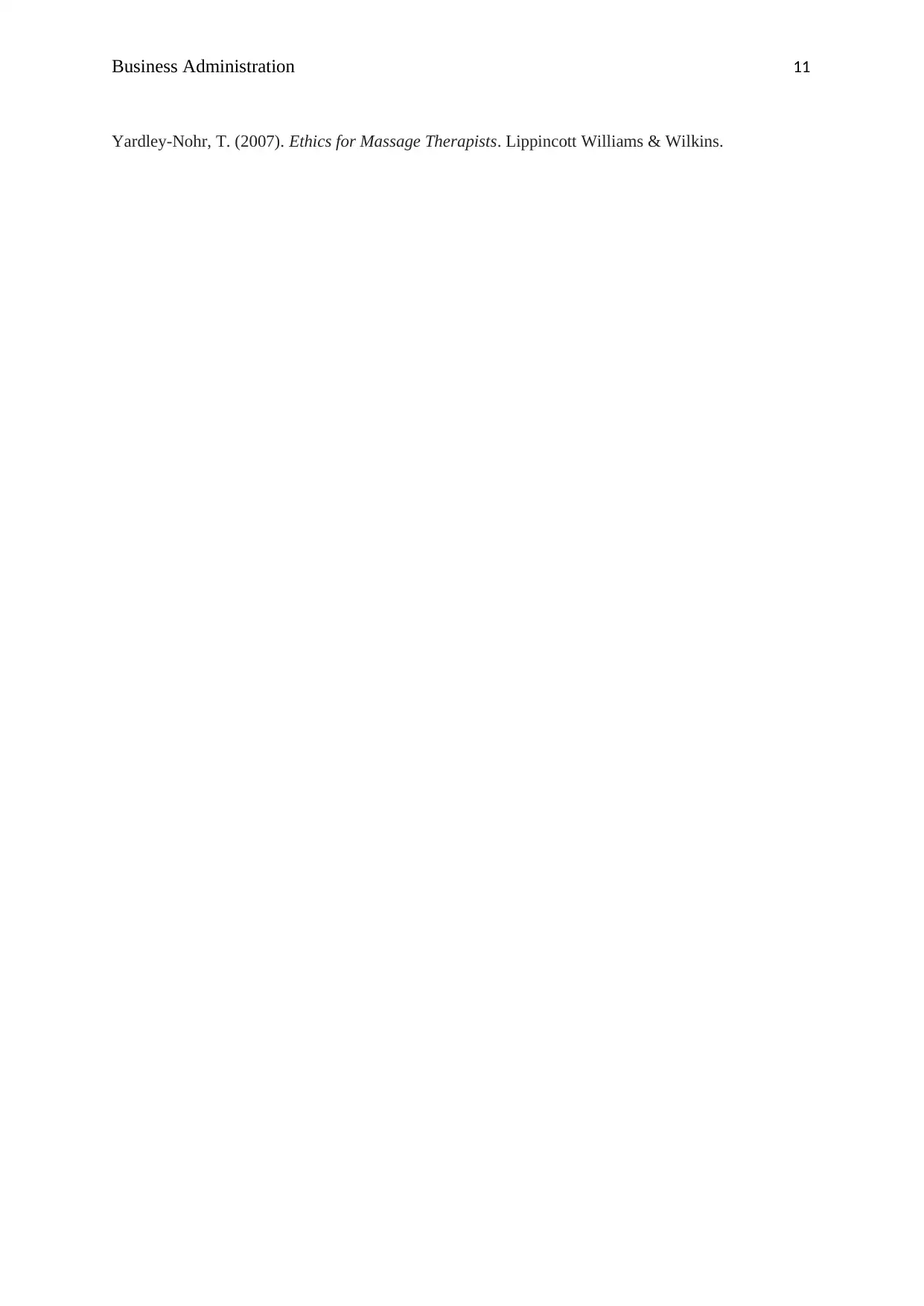
Business Administration 11
Yardley-Nohr, T. (2007). Ethics for Massage Therapists. Lippincott Williams & Wilkins.
Yardley-Nohr, T. (2007). Ethics for Massage Therapists. Lippincott Williams & Wilkins.
1 out of 11
Your All-in-One AI-Powered Toolkit for Academic Success.
+13062052269
info@desklib.com
Available 24*7 on WhatsApp / Email
![[object Object]](/_next/static/media/star-bottom.7253800d.svg)
Unlock your academic potential
© 2024 | Zucol Services PVT LTD | All rights reserved.

